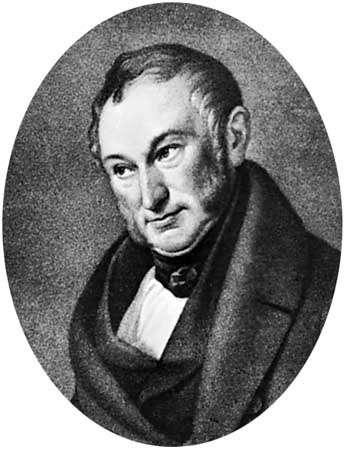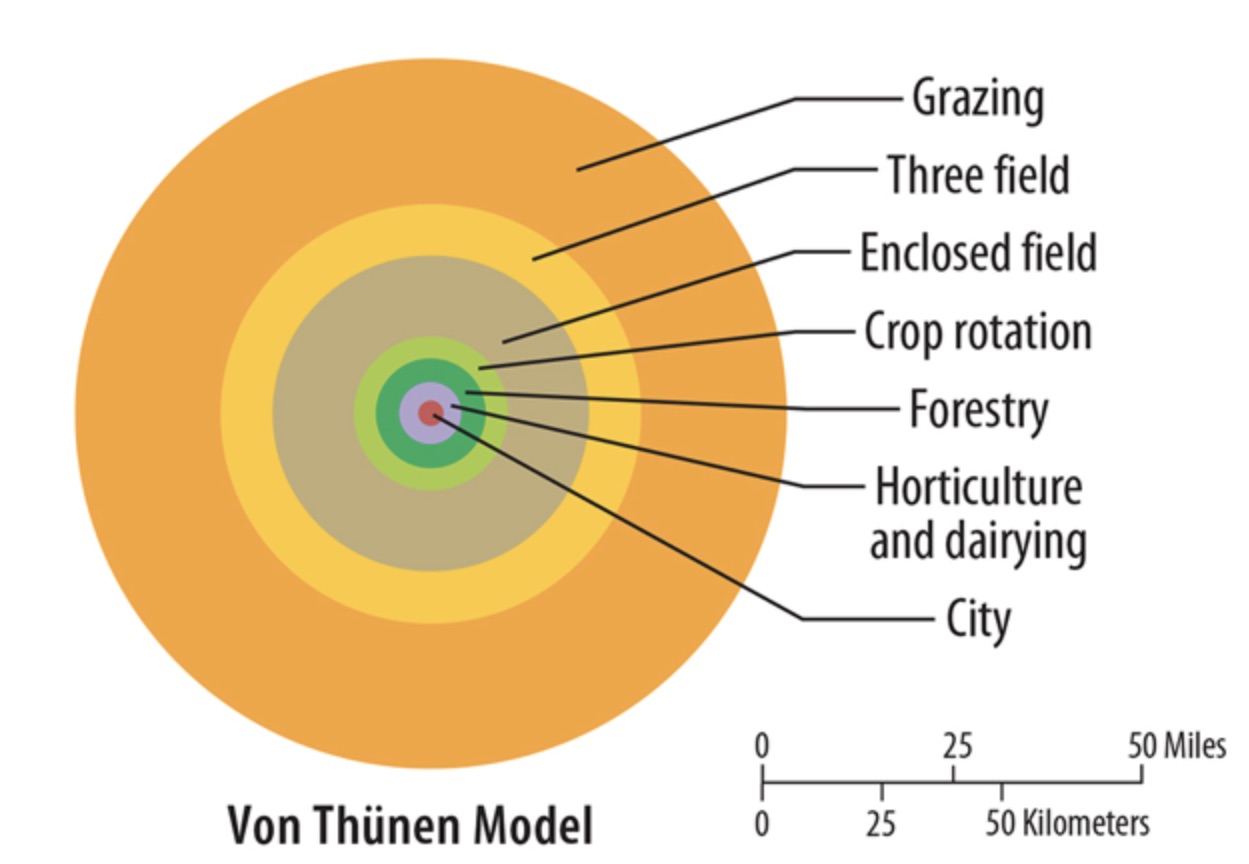Johann Heinrich von Thunen, who lived from 1783-1850, developed the Von Thunen Model of Land Use. Before the industrial revolution, he proposed this model in 1826, in the book entitled The Isolated State. He was a very skilled farmer and was knowledgeable in economics and used this model to look at and understand the different ways people (and market processes) used land in different locations. He was also curious to find out how farmers used different parts of the land to produce different crops.
Von Thunen Theory is also considered as location theory as it deals with spatial distribution of crops, production area, market place, transportation cost, land rent & agricultural location. The impact of location is very much correlated to the economic rent, transport cost, land use and overall effects the production cost. Von Thunen ‘s ideas are often appreciated by students. urban planners, geographers, landowners and people associated with farming and market gardening.

Source: Britannica
Von Thunen believed that there were two factors that determined the location of the crops in one area. These were cost of land and cost of transportation. Another thing he believed was that farmers were driven by maximising profits. Hence, this model talks about commercial agriculture. It focuses on farmers who want to make money. This model is only based on societies that were primarily European.
Human Geography
Human geography is the study of interrelationships between people, place, and environment, and how these vary spatially and temporally across and between locations (Research Guides: Human Geography: Defining Human Geography, n.d.). We rarely speak about human interactions in terms of spatial terms. This discipline is also relatively new in the field of social sciences, but von Thunen was one of the first people to clearly present a method of testing human geography. He used his notes of farm transactions and records to devise a model that explains the way humans use agricultural land. This was the Von Thunen’s Model.
The Model of Agricultural Land Use

Source: Pinterest
In the centre of the model, we have the city or the urban centre (usually known Central Business District or Downtown area). The model revolves around the city. This is the place where you would buy and sell products and make money. Surrounding the city would be four rings of agricultural activity. These are
- Intensive farming and dairying (horticulture and dairying in figure 1),
- Forestry,
- Increasing extensive field crops (crop rotation, enclosed field, and three field in figure 1), and
- Livestock, ranching and grazing. Anything outside the concentric rings would be termed ‘wilderness’. Von Thunen says that since it is too far away and vast, there wouldn’t be any production, hence no profits.
Related Articles:
- Multiple Nuclei Model of 1945 by C.D. Harris and Edward L. Ullman
- Hoyt Model or Sector Model (1939) of Urban Land Use by Homer Hoyt
- Burgess model or concentric zone model (1925) by Ernest Burgess
- Galactic City Model
Assumptions of the model
Before we get into details about the model, there are a few assumptions that Von Thunen made. This was because he wanted the model to be more flexible in nature. They are as follows:
- The city is centrally located, a single market place with no connections. It is self-sufficient with no external influences.
- The city, or isolated state, is surrounded by unoccupied wilderness.
- There exists a homogenous physical environment, where the land of the state is completely flat and has no rivers or mountains to interrupt the terrain.
- Site characteristics like climate, soil quality, etc. are all uniform.
- There are no roads; farmers transport their own goods to market via oxcart, across land, to the city. Hence, transportation is possible in all directions, and the cost of transportation is directly related to distance.
- Farmers are rational and opt to maximise profits.
Rings of the model
Ring 1: Intensive farming and dairying
The immediate ring outside the city is intensive farming and dairying. There are two reasons why Von Thunen places this next to the city. Milk, vegetables, fruits and other dairy products and agricultural products are perishable, hence need to be sold quickly. Producing perishable items next to the city will allow it to be sold faster. The range and shelf-life of these products and perishable crops can be increased with better technology, but this model was created during the 1820’s, where there was no concept of refrigeration. Another reason for the close vicinity to the city. is the cost of transportation. In order for farmers to make any profit of the large quantities of items, it made economical sense for them to be located next to the city.
Ring 2: Forestry
In Von Thunen’s model, the second ring is forestry. This might seem peculiar, but Von Thunen observed that wood is an essential need for people. Timber and firewood was the primary source of fuel and building materials. Keeping it close to the city made it more accessible to the people. Wood is also a very heavy resource. It was located fairly close to the city so that it could be easily transported to the city. This also meant that profit driven farmers can make profits with less transportation cost of wood and less time taken to transport wood to the city.
Ring 3: Increasing Extensive Field Crops
The intensity of farming decreases with increasing distance away from the city. The rings outside forestry would not be as labour intensive as the interior rings. And that is why field crops such as grains for bread are produced here. Grains are very easy to transport. They are light, can be stored in a container, very easy to transport, and have also last longer than dairy products.
Grains need a lot of land. The Bid – Rent theory comes into picture. Since grains need a lot of land to be produced, they are situated further away from the city. This is because land is cheaper and it is easier to transport large amounts of grain to the city. Profit-making is still at play.
Ring 4: Ranching and Grazing
The final ring is provided to the animals for grazing. They need a lot of land. Again, further away from the city means cheaper land. Animals are also self-transporting. They be can be raised far away from the city. When it is time for slaughtering, the animals can be easily transported to the slaughterhouse in the city, and sold off in the market.
Wilderness
Anything past the fourth ring is termed by Von Thunen as wilderness. This area doesn’t necessarily mean that it is uninhabited. There might be hinterlands between different areas. But the idea behind the wilderness is that, people located in this area are located so far away from the city, that you can actually make any profits. There is no motivation for having commercial agriculture this far away. Transportation costs would be too far, and the productivity would be too little.
Related Article: Central Place Theory
Modifications to the Von Thunen Model

Source: Pinterest
Von Thunen soon realised that his assumptions are not observed in real life. He relaxed some assumptions, so he could make it a better analytical tool to understand rural land-use patterns.
One of his concrete assumptions was the transportation is possible in all directions, making every part inter-accessible by roads. This was however, not true, as there were roads that were better, and other modes like railways and waterways being used. He therefore, introduced a navigable waterway into his model. He theorised that because all the items would be brought to central dock of the city along the stream, all the zones outside would be elongated along this stream.
Von Thunen realised that there can multiple market centres instead of one single central market. These new satellite market centres would elongate away from each market centre along the stream.
He considered to relax the assumption that productions costs remained the same except of the costs that are associated with the distance away from the market. The difference in climate, soil, topography, availability of labour, etc. all played roles in production costs.
Criticisms to the Von Thunen Model
Von Thunen’s model did explain the factors on rural land-use planning. But there were criticisms to follow.
- The concept of isolated state, and that of finding regions where agricultural production happens in concentric zones were difficult to be seen in reality.
- Von Thunen assumed that farmers wanted to maximise profits. This was a very bold assumption, as farmers during the feudal times were not keen on making money. Once their basic necessities are fulfilled, like food and water for winter, they would cease to produce more for money. They did not think in terms of profit and loss.
- His concept did not acknowledge traditional rural culture.
Von Thunen’s Model in Today’s World
Von Thunen’s model still kind of exists in our world today. Not necessarily in its exact form, but the principles mentioned in his theory are still applicable. Considering the time in which it was created, and to see that it still exists in some parts, is actually interesting. However, the way how people produce is also changing. Agro-business and production has improved a lot. We now mass produce livestock in confined places to meet the increasing demand. It doesn’t require as much land as before, and that would shift its location. All of our markets are connected globally. Different tastes and culture results in the production of different types of speciality crops and produce. Von Thunen’s model is still relevant in many aspects despite the above changes, especially with relation to production costs, and so on.
Related Concepts/ Articles:
- The Rank-Size Rule by George Zipf (1949)
- Rural Urban Fringe
- Rural Urban Continuum & its causes
- What is Counter Urbanisation?
- Central Business District (CBD) | Characteristics, Examples, Pros & Cons
References
- Johann Heinrich von Thünen | German agriculturalist. (n.d.). Encyclopedia Britannica. Retrieved August 30, 2020, from https://www.britannica.com/biography/Johann-Heinrich-von-Thunen
- Mr.Sinn. (2019, January 30). Von Thunen’s Model of Land Use [Video]. YouTube. https://youtu.be/-HhC1emeUhY
- Otten, G. V., & Bellafiore, D. (n.d.). Modifications of the Von Thünen Model | GEOG 597i: Critical Geospatial Thinking and Applications. GEOG 597i: Critical Geospatial Thinking and Applications. Retrieved August 30, 2020, from https://www.e-education.psu.edu/geog597i_02/node/744
- Otten, G. V., & Bellafiore, D. (n.d.). Reflection on Von Thünen | GEOG 597i: Critical Geospatial Thinking and Applications. GEOG 597i: Critical Geospatial Thinking and Applications. Retrieved August 30, 2020, from https://www.e-education.psu.edu/geog597i_02/node/746b
- Research Guides: Human Geography: Defining Human Geography. (n.d.). Dartmouth Library. Retrieved August 29, 2020, from https://researchguides.dartmouth.edu/human_geography